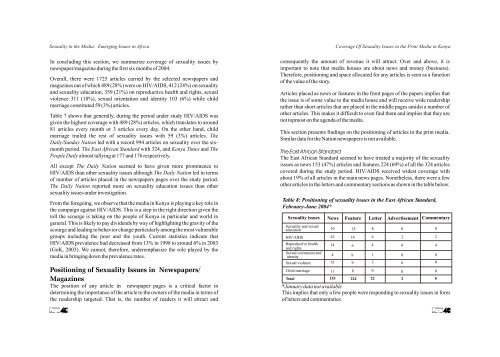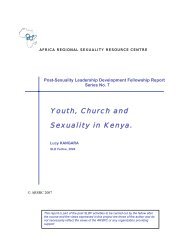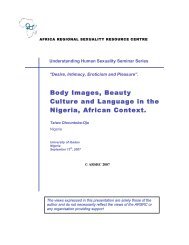Sexuality in Media: Emerging Issues in Africa - Africa Regional ...
Sexuality in Media: Emerging Issues in Africa - Africa Regional ...
Sexuality in Media: Emerging Issues in Africa - Africa Regional ...
You also want an ePaper? Increase the reach of your titles
YUMPU automatically turns print PDFs into web optimized ePapers that Google loves.
<strong>Sexuality</strong> <strong>in</strong> the <strong>Media</strong>: Emerg<strong>in</strong>g <strong>Issues</strong> <strong>in</strong> <strong>Africa</strong><br />
In conclud<strong>in</strong>g this section, we summarize coverage of sexuality issues by<br />
newspaper/magaz<strong>in</strong>e dur<strong>in</strong>g the first six months of 2004.<br />
Overall, there were 1725 articles carried by the selected newspapers and<br />
magaz<strong>in</strong>es out of which 489 (28%) were on HIV/AIDS, 412 (24%) on sexuality<br />
and sexuality education, 359 (21%) on reproductive health and rights, sexual<br />
violence 311 (18%), sexual orientation and identity 103 (6%) while child<br />
marriage constituted 59 (3%) articles.<br />
Table 7 shows that generally, dur<strong>in</strong>g the period under study HIV/AIDS was<br />
given the highest coverage with 489 (28%) articles, which translates to around<br />
81 articles every month or 3 articles every day. On the other hand, child<br />
marriage trailed the rest of sexuality issues with 59 (3%) articles. The<br />
Daily/Sunday Nation led with a record 994 articles on sexuality over the sixmonth<br />
period. The East <strong>Africa</strong>n Standard with 324, and Kenya Times and The<br />
People Daily almost tally<strong>in</strong>g at 177 and 176 respectively.<br />
All except The Daily Nation seemed to have given more prom<strong>in</strong>ence to<br />
HIV/AIDS than other sexuality issues although The Daily Nation led <strong>in</strong> terms<br />
of number of articles placed <strong>in</strong> the newspapers pages over the study period.<br />
The Daily Nation reported more on sexuality education issues than other<br />
sexuality issues under <strong>in</strong>vestigation.<br />
From the forego<strong>in</strong>g, we observe that the media <strong>in</strong> Kenya is play<strong>in</strong>g a key role <strong>in</strong><br />
the campaign aga<strong>in</strong>st HIV/AIDS. This is a step <strong>in</strong> the right direction given the<br />
toll the scourge is tak<strong>in</strong>g on the people of Kenya <strong>in</strong> particular and world <strong>in</strong><br />
general. This is likely to pay dividends by way of highlight<strong>in</strong>g the gravity of the<br />
scourge and lead<strong>in</strong>g to behavior change particularly among the most vulnerable<br />
groups <strong>in</strong>clud<strong>in</strong>g the poor and the youth. Current statistics <strong>in</strong>dicate that<br />
HIV/AIDS prevalence had decreased from 13% <strong>in</strong> 1998 to around 6% <strong>in</strong> 2003<br />
(GoK, 2003). We cannot, therefore, underemphasize the role played by the<br />
media <strong>in</strong> br<strong>in</strong>g<strong>in</strong>g down the prevalence rates.<br />
Position<strong>in</strong>g of <strong>Sexuality</strong> <strong>Issues</strong> <strong>in</strong> Newspapers/<br />
Magaz<strong>in</strong>es<br />
The position of any article <strong>in</strong> newspaper pages is a critical factor <strong>in</strong><br />
determ<strong>in</strong><strong>in</strong>g the importance of the article to the owners of the media <strong>in</strong> terms of<br />
the readership targeted. That is, the number of readers it will attract and<br />
consequently the amount of revenue it will attract. Over and above, it is<br />
important to note that media houses are about news and money (bus<strong>in</strong>ess).<br />
Therefore, position<strong>in</strong>g and space allocated for any articles is seen as a function<br />
of the value of the story.<br />
Articles placed as news or features <strong>in</strong> the front pages of the papers implies that<br />
the issue is of some value to the media house and will receive wide readership<br />
rather than short articles that are placed <strong>in</strong> the middle pages amidst a number of<br />
other articles. This makes it difficult to even f<strong>in</strong>d them and implies that they are<br />
not topmost on the agenda of the media.<br />
This section presents f<strong>in</strong>d<strong>in</strong>gs on the position<strong>in</strong>g of articles <strong>in</strong> the pr<strong>in</strong>t media.<br />
Similar data for the Nation newspapers is not available.<br />
The East <strong>Africa</strong>n Standard<br />
The East <strong>Africa</strong>n Standard seemed to have treated a majority of the sexuality<br />
issues as news 153 (47%) articles and features 224 (69%) of all the 324 articles<br />
covered dur<strong>in</strong>g the study period. HIV/AIDS received widest coverage with<br />
about 19% of all articles <strong>in</strong> the ma<strong>in</strong> news pages. Nonetheless, there were a few<br />
other articles <strong>in</strong> the letters and commentary sections as shown <strong>in</strong> the table below.<br />
<strong>Sexuality</strong> issues<br />
<strong>Sexuality</strong> and sexual<br />
education<br />
HIV/AIDS<br />
Reproductive health<br />
and rights<br />
Sexual orientation and<br />
identity<br />
Sexual violence<br />
Total<br />
Coverage Of <strong>Sexuality</strong> <strong>Issues</strong> <strong>in</strong> the Pr<strong>in</strong>t <strong>Media</strong> <strong>in</strong> Kenya<br />
Table 8: Position<strong>in</strong>g of sexuality issues <strong>in</strong> the East <strong>Africa</strong>n Standard,<br />
February-June 2004*<br />
News Feature Letter Advertisement Commentary<br />
10 25 8 0<br />
0<br />
63 14 6 2<br />
2<br />
14 6 4 0<br />
4<br />
4 9 1 0<br />
0<br />
51 9 3 0 0<br />
Child marriage 11 8 0<br />
0 0<br />
153 224 22 2<br />
6<br />
*January data not available<br />
This implies that only a few people were respond<strong>in</strong>g to sexuality issues <strong>in</strong> form<br />
of letters and commentaries.






